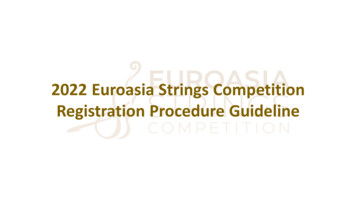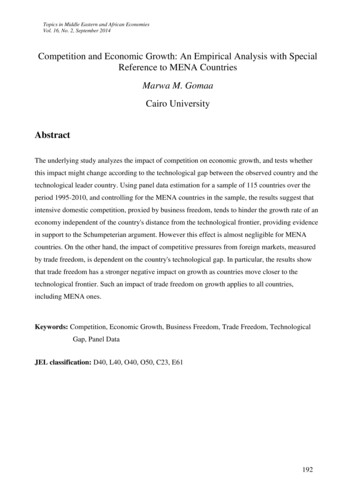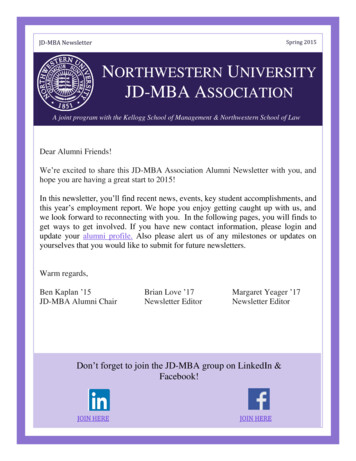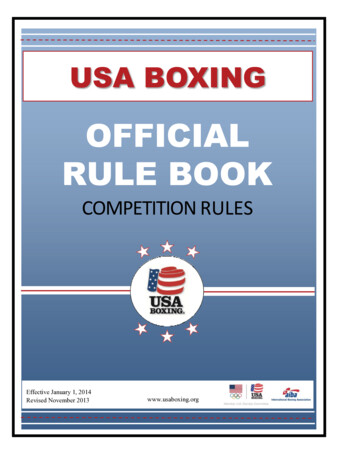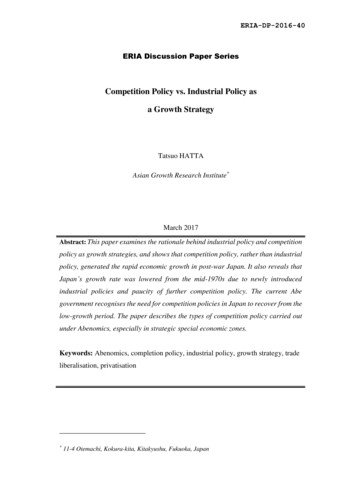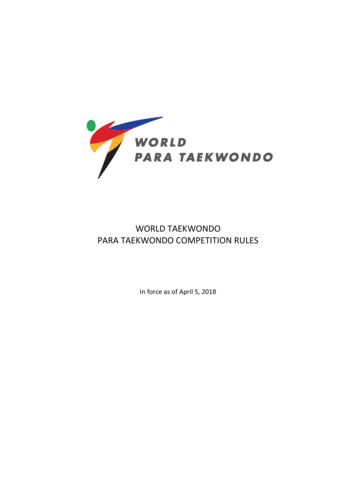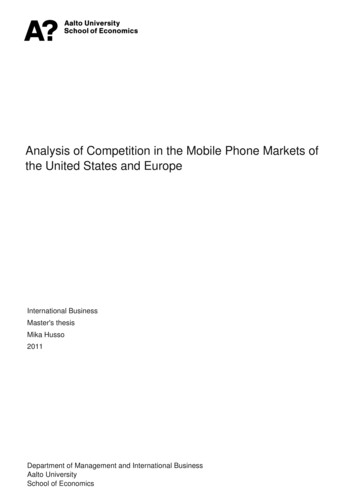
Transcription
Analysis of Competition in the Mobile Phone Markets ofthe United States and EuropeInternational BusinessMaster's thesisMika Husso2011Department of Management and International BusinessAalto UniversitySchool of Economics
AALTO UNIVERSITY SCHOOL OF ECONOMICSABSTRACTDepartment of Management and International businessMaster’s thesisANALYSIS OF COMPETITION IN THE MOBILE PHONE MARKETS OF THE UNITED STATESAND EUROPECompetition in an economic context is a widely studied phenomenon with a significant body ofaccumulated research and theory. However, competition in the mobile phone industry, despite itsprevalence in public discussion, has received significantly less attention in academic research. Within theinternational business (IB) context there are very few academic studies that seek to analyze and comparethe different geographical mobile phone markets from the viewpoint of competition.This thesis examines competition in the mobile phone markets of the United States and Europe in light ofinterviews and secondary data covering years 2002 - 2011. The framework used for the analysis isfounded on concepts drawn primarily from industrial organization (IO) economics, IB theory and microeconomics. The first part of the thesis gives an overview of the U.S. and European mobile phone marketsand the second part focuses specifically on Nokia, its actions and performance on the U.S. market.The findings reveal that the U.S. and European mobile phone markets are fundamentally different. Firstly,while in Europe several parallel sales channels exist, the U.S. market is dominated by mobile operatorsthat control access to the end customer. Secondly, in the U.S. market phones are generally sold heavilysubsidized and bundled, and either under the operator brand or co-branding agreements. In addition, theU.S. market has historically split in two technologies, GSM and CDMA, as opposed to Europe whereGSM is the dominant technology.The analysis of Nokia in the United States shows that the company’s problems appear to be related to thevery characteristics of the U.S. market and the way Nokia has reacted. First and foremost, Nokia has hada difficult relationship with the operators who have required tailoring, technology variations etc. Inaddition to its focus on GSM, Nokia seems to have refused to tailor for operators and insisted on salesunder the Nokia brand. Finally, over the years, Nokia’s situation has been complicated by occasionaldisputes related e.g. to immaterial property rights and recently problems in developing and havingoperators represent especially Nokia’s high-end models.Key words: Competition, mobile phone industry, United States, Europe
AALTO YLIOPISTON KAUPPAKORKEAKOULUTIIVISTELMÄJohtamisen ja kansainvälisen liiketoiminnan laitosPro gradu -tutkielmaYHDYSVALTOJEN JA EUROOPAN MATKAPUHELINMARKKINOIDEN KILPAILU-ANALYYSIKilpailu taloustieteellisessä kontekstissa on laajasti tutkittu ilmiö, jonka alueella on tehty mittava määrätieteellistä tutkimusta. Matkapuhelintoimialan kilpailu sen sijaan, huolimatta sen saamasta yleisestähuomiosta, on jäänyt merkittävästi vähemmälle huomiolle akateemisessa tutkimuksessa. Kansainvälisenliiketoiminnan alueella on julkaistu vain vähän tutkimuksia, jotka analysoisivat tai vertailisivat erimaantieteellisiä matkapuhelinmarkkinoita kilpailun näkökulmasta.Tässä työssä tarkastellaan kilpailua Yhdysvaltojen ja Euroopan matkapuhelinmarkkinoilla haastatteluihinja sekundäärisen lähdeaineistoon pohjautuen kattaen vuodet 2002 - 2011. Työssä käytetty analyyttinenviitekehys pohjautuu teollisten organisaatioiden taloustieteen (IO), kansainvälisen kaupan in, kun taas toinen osa keskittyy Nokiaan, sen toimiin ja menestykseenYhdysvalloissa.Työn tulokset osoittavat USA:n ja Euroopan matkapuhelinmarkkinoiden poikkeavan oleellisestitoisistaan. Ensiksi, Euroopan markkinalla on lukuisia rinnakkaisia myyntikanavia, kun taasYhdysvalloissa operaattorit dominoivat jakeluketjua ja kontrolloivat pääsyä loppuasiakkaalle. Toiseksi,USA:ssa puhelimet myydään tyypillisesti operaattorin tavaramerkille räätälöityinä ja vahvastisubventoituina kytkykaupan ollessa pääasiallinen toimintamalli. Lisäksi, Yhdysvaltojen markkina onjakautunut GSM ja CDMA teknologioihin, kun taas Euroopassa GSM on ollut hallitseva.Työn aineiston analyysi osoittaa, että Nokian ongelmat ovat liittyneet erityisesti Yhdysvaltojenmarkkinan erityispiirteisiin ja siihen, miten Nokia on toiminut suhteessa näihin. Eritoten Nokialla on ollutvaikeuksia operaattorisuhteissaan liittyen puhelinten räätälöintiin operaattoreille, teknologiavariaatioihinjne. GSM:ään keskittymisen lisäksi vaikuttaa, että Nokia on ollut haluton mukauttamaan puhelimiaanoperaattorien vaatimukseen ja vaatinut oman tavaramerkkinsä käyttöä. Vuosien mittaan Nokian tilannettaovat myös vaikeuttaneet riidat liittyen immateriaalioikeuksiin ja viimeaikaiset ongelmat kalliimpienmallien kehityksessä ja saattamisessa operaattorien myytäväksi.Avainsanat: Kilpailu, matkapuhelintoimiala, Yhdysvallat, Eurooppa
Table of Contents1. INTRODUCTION . 11.1. RESEARCH GAP . 31.2. RESEARCH QUESTIONS . 51.3. STRUCTURE OF THE THESIS . 52. THEORETICAL BACKGROUND . 62.1. ANALYTICAL FRAMEWORK . 62.2. MACRO-ENVIRONMENT . 72.3. MICRO-ENVIRONMENT. 82.4 CONCEPTUAL APPROACHES . 153. MARKET DESCRIPTION . 263.1. DESCRIPTION OF THE MOBILE PHONE MARKET . 263.2 FIVE FORCES ANALYSIS . 283.3. EUROPE . 323.4. UNITED STATES . 373.5. EUROPE AND THE UNITED STATES – SIMILARITIES AND DIFFERENCES . 434. METHODOLOGY . 464.1. CASE STUDY RESEARCH . 464.2. CASE STUDY SETTING . 494.3. DATA COLLECTION . 524.4. DATA ANALYSIS . 554.5. VALIDITY AND RELIABILITY . 565. CASE STUDY FINDINGS . 585.1. NOKIA’S PERFORMANCE IN THE UNITED STATES . 585.2. CHARACTERISTICS OF THE U.S. MARKET . 706. DISCUSSION AND CONCLUSION . 796.1. THEORETICAL IMPLICATIONS AND DIRECTIONS FOR FUTURE RESEARCH . 806.2. MANAGERIAL IMPLICATIONS . 856.3. LIMITATIONS OF THE STUDY . 87REFERENCES . 88INTERNET SOURCES . 97
1. IntroductionThe introduction of the 1st generation of mobile handsets and networks in the early1980s started a gradual but irreversible process that has fundamentally changed the waypeople communicate. What was originally seen as a complementary and later substitutemeans to fixed-line telephony has over the 2nd, 3rd and now 4th generation of mobilecommunications transformed into an irreplaceable part of people’s lives in everycontinent with close to 4,6 billion worldwide users (ITU, 2010) and global annual unitsales exceeding 1,1 billion in 2009. (Nokia, 2010c) Where in developing countriescalling and basic messaging still dominate, in more advanced countries phones are usedin many professional and personal contexts including, for example, exchange of emails, photography, Internet and social media.This tremendous change has been enabled by technological advances in areas such aselectronics and telecommunications produced by hundreds of universities andcompanies around the world, but still much of the credit should be directed to thosecompanies involved in the very business. Mobile handset manufacturers, Nokia in theforefront, invest tens of billions of euros each year and employ tens of thousands ofpeople in positions related to handset development. As of December 21, 2009, Nokiaalone employed 17 196 people in research and development (R&D) with R&D relatedexpenses totaling 5,909 billion euros. (Nokia, 2010b) Recently, however, thestandardization of electronic components and increase in in-built processing power hasshifted R&D focus strongly from hardware to software favoring companies traditionallystrong in software R&D.In part due to the transformation of the mobile phone industry, the competition inhandset manufacturing has become increasingly intensive and aggressive. The increasedsoftware focus has lowered barriers to entry related to hardware expertise and attractedseveral new entrants such as HTC, Apple and Google to the market. Simultaneously, themobile phone business has moved towards competition of mobile eco systems1
comprising phones, mobile operating systems, application stores, cloud services, etc.further increasing the complexity and dynamic nature of the industry.This transformation has taken place gradually over a few years on all technologicallyadvanced markets including Europe and the United States. Even though the two marketspresent similar levels of sophistication in terms of actors, purchasing power etc. thedevelopment of these markets has taken two different routes both technology-wise andrelated to market structure and competition. While in the European mobile phonemarket handset manufacturers utilize a wide range of marketing and distributionchannels to reach the end customer, the mobile operator dominance over the distributionnetwork in the United States forces handset manufacturers to cooperate with theoperators who constitute the only major sales channel.In addition to the differences in the market composition the European and U.S.operators have partly opted for different cellular technologies. While in Europe, theGlobal System for Mobile Communications (GSM) has been the dominant technology,two out of the four biggest U.S. operators have adopted a competing technology CodeDivision Multiple Access (CDMA). These and other more subtle differences of theEuropean and U.S. mobile phone markets have necessitated distinct approaches to eachmarket on the part of the handset manufacturers.This thesis contributes to the on-going discussion on competition and competitivedynamics in the mobile handset industry by carrying out an analysis of the markets ofEurope and the United States with a special focus on the case of Nokia in the UnitedStates. Especially, the thesis will make an effort to analyze the roots of Nokia’s failureto gain and retain its market share in the United States despite its dominant position inmost of the world.2
1.1. Research gapDespite the extensive news coverage (see Appendix II) and the scope of market andcompany analyses on the mobile handset industry, the availability of rigorous academicresearch is scarce. This is especially true in regard to analyses that focus on theEuropean and U.S. mobile phone markets and/or the performance of individualcompanies in these markets. This is a finding of interest since, somewhat surprisingly,the mobile operator industry (as opposed to the mobile handset industry) has alreadygained significant academic attention and the body of research is substantial. Thisresearch covers wide range of topics, for instance, competition between operators(Cricelli, Grimaldi & Ghiron, 2008; Fernández & Usero, 2009), operator strategies(Peppard & Rylander, 2006; Kiiski. & Hämmäinen, 2004), and customer retention andloyalty (Kim & Yoon, 2004; Gerpott & Rams, 2001).Another neighboring industry with a solid research base is the personal computer (PC)business. Bresnahan & Greenstein (1999) analyzed the technological competition in thePC industry focusing on the importance of platforms (e.g. Apple Macintosh vs. IBM).This research could serve as a basis for similar research related to the operating systemsor application development environments in the mobile handset industry. Other studieshave focused e.g. on the effect of advertising in the PC industry (Goeree, 2008) and onthe formation of the industry in the United States (Haigh, 2010). Malerba et al. (2008)presented a model for analyzing the varying vertical integration of computer firms overtime. It should still be noted that the research on mobile operator and PC industries isnot, obviously, directly applicable to the mobile handset industry. However, thesestudies function as a point of comparison when investigation the same phenomena in anunstudied industry.Recent research on the mobile handset industry has focused mostly on a few majorresearch streams. Hess (2006), Li (2002), Maitland (2002) and Funk (2009) haveanalyzed the value chain structures of the mobile phone industry globally, in Europeand Japan, respectively. Rouvinen (2006) and Gao (2009) have looked at the industry3
and its development from the perspective of developing countries while several authorsincluding Xie & White (2006) and Lie et al (2009) have given special attention to theChinese market. Another major research stream related to the handset market is that ofsubsidies. Several authors e.g. Kim et al. (2004) and Tallberg et al. (2007) haveanalyzed the effect of mobile phone subsidies on the industry and competition fromdifferent viewpoints. Obviously, a great number of other topics have been researchedrelated to the mobile industry such as new product development by Koski & Kretschmer(2010) and industry ecosystems by Gueguen & Isckia (2010) and Basole (2009).Among the very few analytical articles with a focus on the handset market andmanufacturers is that of Zhang & Prybutok (2005) “How the Mobile CommunicationMarkets Differ in China, the U.S., and Europe”. This article makes an attempt tosummarize the main macro level differences of the three markets including standards,price structures, regulation, demographics, usage patterns, business potential, andtechnology adoption. Still, despite being written by two professors in the field, thisletter type magazine article is directed to a very broad audience and cites practically noacademic studies. Another attempt to capture some attributes of the competitionbetween companies is that of He et al. (2006) where they analyze the process by whichEricsson, Nokia and Samsung caught up with the once-leader Motorola technologywise.Thus, it appears that regional mobile phone markets, especially Europe and the UnitedStates, are practically untouched from the viewpoint of competition between companies.However, several non-academic books have been written (Hyöty, 2011; Steinbock,2010, Hakkarainen, 2010; Steinbock, 2003; Burnham, 2002) and numerousconsultancies produce yearly or even quarterly analyses of the industry (Gartner, IDC,Strategy Analytics, Nordic Partners). Still, these publications are not intended asacademic research and often normative in nature.4
1.2. Research questionsThe primary aim of the thesis is to gain understanding of the characteristics of theEuropean and the U.S. mobile phone markets from the viewpoint of competition. Inorder to gain additional insight into how these characteristics affect the companies, aspecial case focusing on Nokia in the United States will be investigated.The main research questions can be summarized as follows:1) What are the specific characteristics of the European and the U.S. mobilephone markets?2) In what respect are the two markets fundamentally different and why?3) Why has Nokia been unsuccessful in the U.S. market?1.3. Structure of the thesisThe thesis is organized as follows. In Chapter 2 a literature review and the theoreticalframework are presented. Chapter 3 reviews the structure of the mobile phone valuesystem and the historical development and current state of the European and the U.S.mobile phone markets. Chapter 4 provides a discussion on the chosen methodology andcase study procedure while Chapter 5 reviews case study findings. Chapter 6 concludesthe thesis with theoretical and managerial implications, limitations and directions forfuture research.5
2. Theoretical backgroundThis thesis utilizes two highly interrelated and well established fields of businessresearch. Firstly, the main goal of the work is to analyze the competitive situation in themobile phone industry in the European and U.S. markets. This aim will be approachedby means of classical competition theories (Industrial Organization, IO) and relevantframeworks (Porter’s five forces) discussed in Section 2.1. Secondly, the thesis seeks tofind explanations for Nokia’s unsatisfactory performance in the United States by meansof case analysis. The applied case methodology is described in Chapter 4.2.1. Analytical frameworkAs the main objective of this thesis is to analyze the European and the U.S. mobilephone markets, the selected framework supports this aim by approaching the markets ontwo different levels. Primarily, the analytical framework focuses on micro-environmenti.e. looking at the markets from the viewpoints of the actors (suppliers, distributors,customers) and from that of competition. To analyze the contribution of each of theseactors and other sources of competition, another well-established model, Porter s fiveforces, will be utilized (Section 2.3). Where necessary, the observed phenomena are alsointerpreted from a wider, macro environmental perspective although more detailedanalysis of macro-environmental factors will be omitted. The exclusion is justified bythe fact that competition, even though influenced by the macro environment, takes placewithin the micro environment. In addition, concentrating on the micro-environmentallows a broader and more in-depth treatment of the most relevant actors present in themicro-environment.On another dimension, the framework applies two different conceptual approaches,namely, international business (IB) environment and industrial organization mentthestronglymicroeconomics focused framework with suitable concepts grounded in the strongly6
related IB and IO disciplines. While the industrial organization focuses on thecompany/market boundary from the perspective of imperfect competition, internationalbusiness focuses on the qualities of international markets and companies operatingacross country boundaries. These approaches will be discussed in detail in Section 2.4.The analytical approach of the thesis is summarized in Figure 1.Macro environmentMicro environmentSuppliersInternational business(IB)DistributorsIndustrial organization(IO) economicsCustomersCompetitionFigure 1. Analytical framework of the study2.2. Macro-environmentBy definition, the macro-environment involves factors outside of the direct control ofthe business. These factors, then, include the economy, government policies, socialchanges etc. A firm may, for example, be influenced by new legislation or changes intaxation policies but the firm rarely has power to shape them itself. Thus, macro factorshave the ability to fundamentally change the environment of an organization but therelationship is typically one way. (Gillespie, 2007) One of the most utilized frameworksto analyze the macro factors is the PESTEL analysis.The PESTEL framework stands for “Political, Economic, Social, Technological,Environmental and Legal” and is used for analyzing the macro-environment in which7
companies operate and which also significantly affects each business independent of itssize (Johnson et al., 2006:65) Similar acronyms such as ETPS, STEP, PEST, andSTEEPLE are often used (CIPD, 2011) in each case including (or excluding) somefactors and giving more weight to some in comparison to others. However, it alwaysaims at capturing the essential of the macro-environment under a few broad categoriesto facilitate understanding and management of each factor within the business and toidentify the key drivers of change (Johnson et al., 2006:69).Typical examples of the PESTEL factors are given in Table 1.Table 1. Components of the PESTEL analysis (Gillespie, ironmentalLegalIssuesEU enlargement, the euro, international trade, taxation policyInterest rates, exchange rates, national income, inflation, unemployment, StockMarketAgeing population, attitudes to work, income distributionInnovation, new product development, rate of technological obsolescenceGlobal warming, environmental issuesCompetition law, health and safety, employment lawEven though the macro-environment will not be analyzed in detail in this thesis itsinfluence in a company’s decision making processes is evident as well as its ability tochange to conditions under which competition takes place. For example, the Finnishgovernment’s decision to allow bundling of mobile phones had a direct impact on bothhandset manufacturers’ and mobile operators’ business. Thus, references to the macroenvironment and changes in it will be made alongside the analysis on companies andtheir micro-environment.2.3. Micro-environmentThe micro-environment can be defined as consisting of “stakeholder groups that a firmhas regular dealings with” (Gillespie, 2007). For the purpose of this thesis, the focuswill be on suppliers, distributors, customers and competition as illustrated in Figure 1following the concise definition of micro-environment by Gillespie (2007).8
SuppliersIn regard to its suppliers, any company generally needs to address questions such as“Can they provide the quality we require at a good price?”, “Can they adjust to changesin the supply volume?” and “What is out power relative to our suppliers and viceversa?” Increasingly, however, large multinational companies in particular areconcerned about the ethicality of their suppliers’ operations. Recently, for example,Nokia was alleged to have used so called ‘blood metals’ in their mobile phones, towhich Nokia responded by implementing yet more stringent systems to track the originof its raw materials (Yle, 2010).Especially in the business of mobile phone manufacturing, suppliers and supply chainmanagement (SCM) play a crucial role. Since mobile phones, smart phones inparticular, contain numerous highly specialized components and modules, handsetmanufacturers generally acquire most of the components, software and even assemblyfrom their suppliers and subcontractors (see the mobile phone value system in Figure 9).Nokia, for example, lists 35 countries as its main supplying locations and applies its socalled Code of conduct to all its business partners. In the Code of conduct (Nokia,2011f) Nokia states that“ Nokia encourages its partners, subcontractors, or suppliers to strive beyondlegal compliance in areas such as governance, human rights and theenvironment. Nokia incorporates ethical, social and environmental criteria in itsprocurement agreements and commits to monitoring the performance of itspartners and to taking immediate and thorough remedial steps in cases wherethe ethical performance of its business partners comes into question.”- Nokia11.1.2011 (Nokia, 2011f)Thus, mobile phone manufacturers rely on suppliers to varying but generally greatextent and can even be held responsible for choosing suppliers that use e.g. child labouror non-recyclable materials. To construct an iPhone, Apple, for example, sources itsRetina display from LG, the A4 processor from Samsung, gyroscopes fromSTMicroelectronics, touch sensitive panels from Wintek and TPK, and chips from9
Skyworks Solutions and TriQuint Semiconductor (AppleInsider, 2010). However, someconglomerates, e.g. Samsung manufacture most of the modules in-house which enablescutting down the number of suppliers and facilitates integration in the productionprocess. Even if the recent business wisdom has advised companies to divest non-corefunctions and focus on a few core competencies, Samsung has proven thatconglomerates may be highly profitable while retaining their non-core parts. UnlikeMotorola, Samsung kept its component manufacturing in-house and focused onsynergies from producing both components and end products. (Hyöty, 2011:250-252)DistributorsThe second essential element of a company's micro-environment is distributors. Thechoice of distribution channels is critical for a number of reasons. Firstly, thedistributors strongly influence the final sales price of each product and thereby directlyaffect the sales quantity. Second, the distributors and later retailers play an importantrole in how the product is presented to the customer and, to some extent, how it ispositioned relative to competing products. Finally, the choice of the distribution channelaffects how customers perceive the brand. While Nokia, for example, utilizes a widerange of sales channels for its Nokia branded products, it sells its luxury phone brandVertu (typically gold and diamond decorated, ranging from 6000 to 300 000) only inVertu and Nokia flagship stores (Vertu, 2011; Dialaphone, 2007)In the mobile handset business, the distribution channel plays a crucial role. While inEurope most mobile phone manufacturers rely on a large number of individualdistributors and retailers, in North America the bulk of handset sales is carried out bymobile network and virtual operators (see Figure 22). The long-lasting dominance ofmobile operators over distribution in the United States has allowed them to introduceadditional requirements related to e.g. tailoring and branding of phones, and togetherwith subsidies a commanding position in the industry. Still, the choices related todistribution come down to the same basic questions, i.e. what are the total costs, how isthe brand communicated, how flexible is the distributor etc.10
CustomersThe third element of the company's micro-environment is customers. In this respect, it iscommon to separate between individual consumers and organizational (or industrial)customers (or buyers). While consumers are traditionally considered less rational andimpulsive in their decision making process, companies tend to be viewed asprofessional buyers following strict budget, cost and profit considerations. (see e.g.Webster & Wind, 1972; Baumgartner & Steenkamp, 1996) These kind of cleardifferences in purchasing behaviour have been questioned (Wilson, 2000) and today’sB-to-B marketers widely recognize that emotions play an important role also in businessbuying decisions (Kotler & Armstrong, 2006:178).In the mobile phone business, consumers represent an enormous variety of tastes,preferences and affluence. In developing countries, the sales of low-end mobile phones(often under 50) dominate, while in developed markets of e.g. Europe and NorthAmerica, consumers often opt for more advanced models incorporating cameras, GPSnavigation, Internet browsing etc. Moreover, most of these consumers appreciate valueadded features and post-purchase services provided by the manufacturer (e.g. AppleApp Store, Nokia Ovi Store and Google Android Market) and often base their purchasedecision on the combination of the phone and the availability of these services (see e.g.Singh & Goyal, 2009). Industrial buyers, on the other hand, tend to value servicesrelated business use of the phone (e-mail, data security etc.) and supplier's ability toprovide a communications solution to the company instead of only handset
advanced markets including Europe and the United States. Even though the two markets present similar levels of sophistication in terms of actors, purchasing power etc. the development of these markets has taken two different routes both technology-wise and related to market structure and competition. While in the European mobile phone




